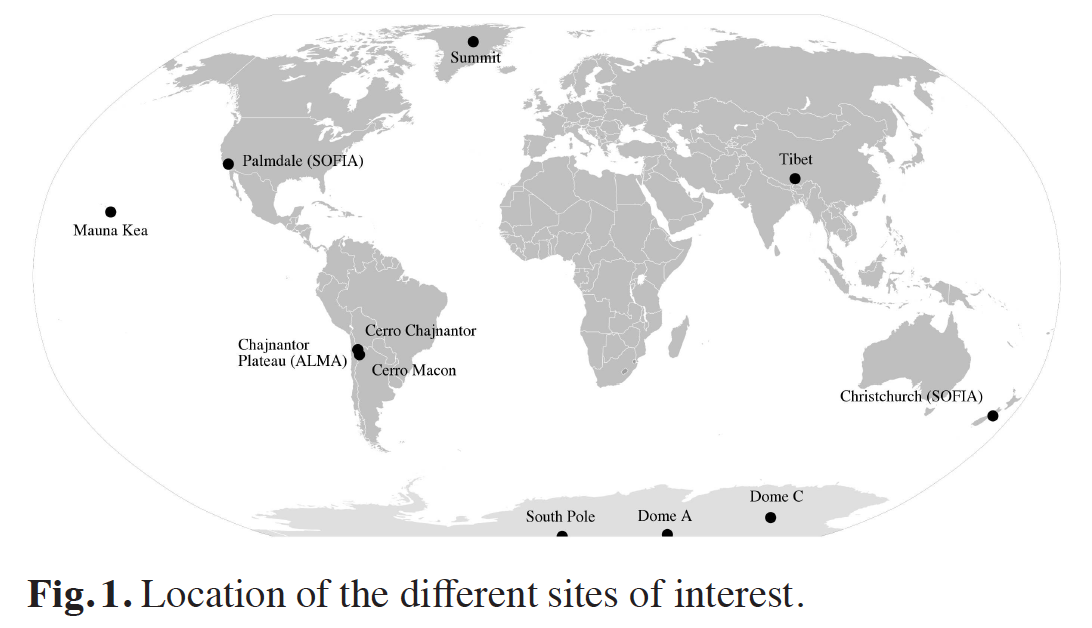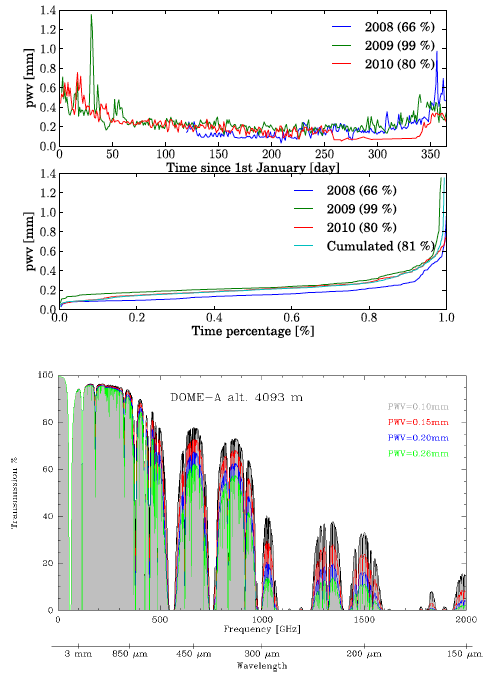Title: Worldwide site comparison for submillimetre astronomy
Authors: Tremblin, P.; Schneider, N.; Minier, V.; Durand, G. Al.; Urban, J.
First Author’s Institution: Laboratoire AIM Paris-Saclay, France
 When it comes to planning and building new telescopes, the site selection is an important consideration. Specifically for telescopes which detect submillimeter (sub-mm) to far-infrared (far-IR) radiation, the goal is to select a site beneath the least amount of tropospheric water vapour present in the Earth’s atmosphere, because water vapour absorbs some of the radiation before it can arrive to the telescope.
When it comes to planning and building new telescopes, the site selection is an important consideration. Specifically for telescopes which detect submillimeter (sub-mm) to far-infrared (far-IR) radiation, the goal is to select a site beneath the least amount of tropospheric water vapour present in the Earth’s atmosphere, because water vapour absorbs some of the radiation before it can arrive to the telescope.
This paper evaluates eleven sites around the world, including current and proposed sites of sub-mm observatories (Antarctica, North/South America), airborne SOFIA locations, and northern-hemisphere sites that could be of interest for future observatories (Summit in Greenland, Yangbajing in Tibet), shown in the map to the left.
Site data were collected with the Infrared Atmospheric Sounding Interferometer (IASI), which was launched in 2006 on the METOP-A satellite. Whereas previous site studies used ground-based instruments at individual sites to measure the atmosphere (looking from the ground up), from IASI’s polar orbit it can see each point on the Earth at least once per day (looking from the sky down). Being able to test all locations with the same instrument working conditions and calibration techniques makes it possible for Tremblin et al. to analyze a very consistent dataset.
IASI measured humidity and pressure at different altitude levels above the sites, and also the integrated (or total amount of) water which is expressed as Precipitable Water Vapour (PWV). Then, the authors use the code MOLIERE-5.7 to calculate the percentage of radiation that arrives at each site over a range of wavelengths, called a transmission curve (shown in the figure below), based on the temperatures and pressures of the atmosphere. This code considers molecules such as water, oxygen (O2), ozone (O3) and nitrogen (N2) (among others) which absorb radiation specifically at short wavelengths, or continuously across all wavelengths.

(top) PWV throughout the year; (middle) Percentage of time at each PWV level; (bottom) Transmission percentage of radiation for a range of wavelengths (or frequencies) for the Antarctic site Dome-A.

Statistics for the ALMA site, Cerro Chajnantor in Chile (see caption to left for explanation). Notice higher PWV on the y-axes, and generally higher variation in PWV throughout the year, compared with Dome-A.
The results and rankings (from driest site to least dry): Antarctica, South America, northern hemisphere sites. In addition to hosting the overall driest sites, Antarctica also has very stable conditions, in that the transmission is high and the standard deviation relatively low. Other sites have higher variability, such that the fluctuations of transmission are greater than the average transmission. In the case of South America, 25% of the time the transmission is as good as in Antarctica because the South American sites have very high elevations. But, averaged over a longer period of time, Antarctic sites are favorable, particularly because of the long winters when night-time lasts several months and conditions stabilize.
Among the northern hemisphere sites, the authors note that “it is remarkable” that the site of Summit in Greenland offers comparable observing conditions, considering PWV and altitude, as Mauna Kea in Hawaii, suggesting a new possibility for sub-mm astronomy in the northern hemisphere. Currently, Mauna Kea hosts 13 working telescopes for optical, IR, sub-mm and radio astronomy.
Finally, the authors are still investigating atmospheric models and data calibration to analyze data pertaining to SOFIA, the airborne observatory which began science flights in 2011. They compare MOLIERE with other atmospheric models and they suggest that a more detailed understanding of the atmosphere at the border between the troposphere and the stratosphere is needed particularly for the higher frequencies that SOFIA detects.
In summary, if you’re planning the next sub-mm or far-IR observatory, keep in mind that Antarctic sites are unique for their overall transmission and stability, but that 25% of the year Cerro Chajnantor presents transmission comparable to Antarctica. If you’re considering a northern hemisphere observatory, perhaps in a quest for all-sky coverage once you’ve gotten data from the optimal southern sites, then Summit in Greenland may offer comparable conditions to Mauna Kea. The authors have created a calculator for PWV statistics and transmission which is available to the community at this site. They will add a fourth year of data for these sites, and also offer to investigate other potential sites upon request.
